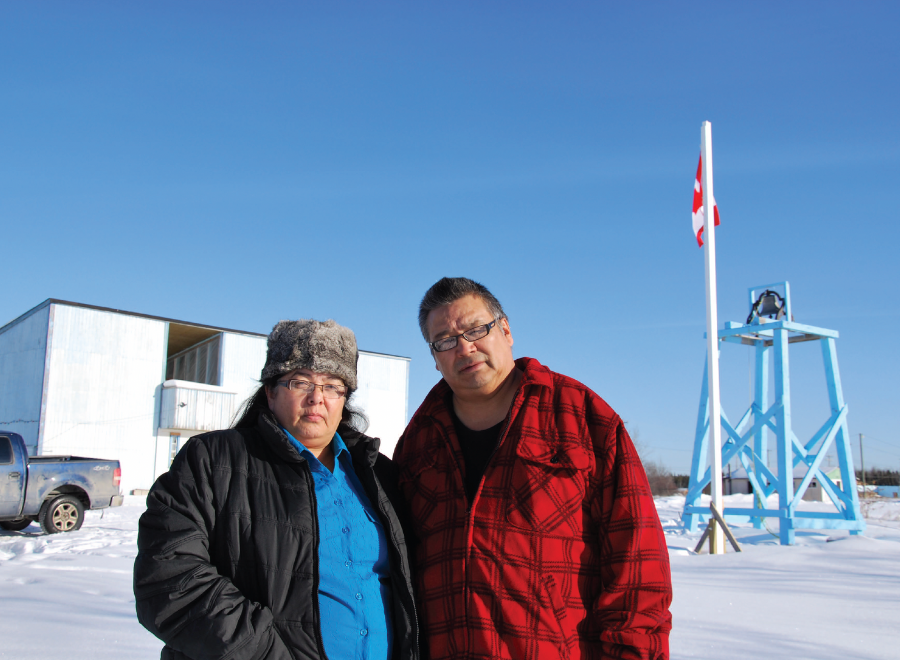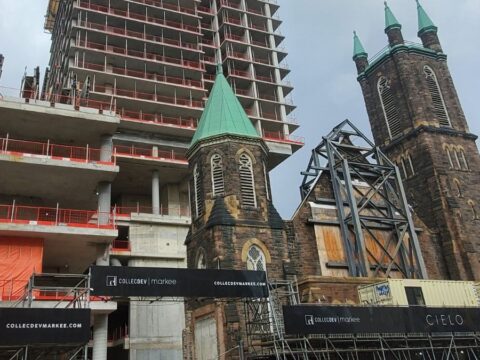The 100-kilometre winter road between the northern Manitoba communities of Berens River and Poplar River snakes across frozen rivers and muskeg and through a vast boreal forest. By southern standards, the road is slow and slippery. For Roy and Delores Bouchie, the ministry team at Berens River United, it’s a pastoral lifeline.
After a busy weekend at the church, Roy Bouchie is headed north to meet elders at Poplar River United and the local band council. The First Nations community of about 1,300 people has been without a United Church minister for more than two years.
You may unsubscribe from any of our newsletters at any time.
Like a modern-day circuit rider, Bouchie fills in as minister at Poplar River and at Little Grand Rapids and Pauingassi, three hours away by car on yet another winter road.
Poplar River United was built in partnership with Roman Catholics 16 years ago, but the priests and bishop now in charge are cool on ecumenism. Statues of saints crowd the chancel, new priests’ living quarters were attached to the building without consultation, and relations are strained. A few United Church elders and lay people usually gather after mass on Sunday for prayer and Bible readings.
When we arrive after a two-hour drive up the eastern shore of Lake Winnipeg from Berens River, the Poplar River United elders seem happy to see us and the band council agrees to fix the manse furnace and send a $900 donation to Presbytery. But without a resident minister, United Church impact in the community is limited. Across town, a large, fully staffed Pentecostal house of prayer is thriving.
Welcome to the Indigenous United Church in Canada’s north. Logistics, living expenses, community needs and First Nations politics are daunting. Church buildings and manses are deteriorating or non-existent, and ministers are stretched thin to cover vacancies.
While only small numbers of worshippers attend and financially support their churches regularly, ministers are nevertheless in high demand for counselling or support, with entire communities depending on them for baptisms, weddings and funerals.
With the related legacies of residential schools and colonialism never far from the surface, the United Church identifies working toward right relations with Indigenous peoples as a priority. It spends about $5 million a year, or 12 percent of the General Council budget, on it. But it’s one thing to name a priority; it’s another to make it work on the ground. Grants that fund work in First Nations communities have dropped 15 percent in the past three years. Indigenous churches and the challenges they face are a world apart from the mainstream United Church.
Yet amid the challenges are signs of hope and some promise that the United Church could help make a difference in isolated Native communities.
It’s Saturday night at Berens River United. About 50 people from across the local church spectrum have gathered for a coffee house. Jokes and banter in Saulteaux and English warm the room. Children play in the snow outside, run around the room or draw pictures quietly at a table in the hall.
“Okay,” says Roy Bouchie, after a rousing gospel number with Delores on drums and her brothers Axel and Glen Flett on steel and bass guitars, “who wants to share a song? I know some people have brought one with you tonight.”
Bouchie coaxes singers to the microphone. Some sing old hymns, but the music that goes over best is upbeat, amplified country gospel.
Monthly coffee houses at the church offer a faith-driven alternative to the often harsh realities of life in these communities. Not far down the road, one of the town’s several bootleggers sells alcohol, lacquer and other solvents. Drugs are also available. The violence that goes along with substance abuse touches everyone.
The United Church and its Methodist precursor have been a presence in this part of northern Manitoba for 138 years. Some, like Rev. John Niddrie in the 1920s and ’30s, stayed long enough to gain local trust and appreciate the Saulteaux culture. Much later, at least one United Church minister left amid unresolved reports of sexual abuse.
Today, one-third of the 34 congregations that make up the United Church’s All Native Circle Conference can be found here, in Keewatin Presbytery. Keewatin also accounts for seven of the Conference’s nine vacant pulpits.
Roy and Delores Bouchie are part of a new wave of homegrown Indigenous leaders in the United Church. They were born and raised in Berens River and have been ministering there for 12 years while continuing their studies at the Dr. Jessie Saulteaux Resource Centre in Beausejour, Man. Four of their children and 14 grandchildren live nearby, plus grandmothers, cousins, aunts and uncles, forming a strong local net of family and community connections.
In a bygone time, United Church ministers in northern First Nations communities competed against their Roman Catholic counterparts for converts and students for local day schools and area residential schools. For ministers like the Bouchies, the competition today comes mainly from Pentecostals.
Travelling evangelists from the southern United States arrive each summer, sometimes bolstering local congregations but more often creating divisions. Rev. John Thompson, minister at Vernon Grieves Memorial United in Oxford House, says it’s the same story elsewhere across northern Manitoba, where preachers “just get people stirred up” before packing up their tents and heading home.
Economically, Berens River is better off than many Indigenous communities in northern Manitoba. About 320 kilometres from Winnipeg, the First Nation is home to about 30 commercial fishers and 20 area traplines. Most of the 2,000 residents still speak Saulteaux, an Ojibwe dialect.
Officially, unemployment is 40 percent; unofficially, it’s as much as twice that. Those with jobs work for local stores, schools, health and social services or the band, which might mean hauling drinking water, sewage or firewood; operating a band-owned rock-stack crushing plant and sawmill; or maintaining roads and buildings. A new $5-million provincially funded dialysis unit is under construction. Future plans include a $10-million contract for work and on-the-job training on an all-season road.
Both Berens River and Poplar River have safe drinking water, habitable schools and church buildings that are usable if not ideal. They stand in happy contrast to other communities in the region. For example, many residents of Red Sucker Lake, Man., and Garden Hill, Man., have to haul their water in buckets and jugs because drinking-water cisterns in both communities are contaminated.
Further north in the Bunibonibee Cree Nation at Oxford House, the local elementary school was closed for most of last year because of mould contamination. Similar structural problems plague United Church-owned buildings in the region. A 2008 engineer’s report condemned and closed churches in Wasagamack, Man., and Red Sucker Lake and ordered repairs to many others.
“Let’s face it,” says Thompson, chair of Keewatin Presbytery and a 40-year veteran of northern Indigenous ministry, “it’s a third-world reality within our own borders.”
It’s a reality that Erik Mathiesen, the Toronto-based General Council staff-person who handles funding to repair and maintain General Council-owned buildings, is trying to address.
In the North, he says, “all the rules and guidelines that apply in the rest of Canada get thrown out the window.” Building projects normally need quotes from three contractors; remote churches often can’t get one. In communities like Berens River, where ministers are in place, they can at least have materials delivered and arrange for local labour to complete the work when repairs are needed.
To solve manse problems, the church has purchased three mobile homes that can be moved over winter roads. One is currently awaiting installation in Garden Hill.
Mathieson says money is also available for repairs or new buildings, but projects need drawings and construction plans — plus servicing agreements with bands — in place. Then there are logistics: materials have to be shipped on winter roads. Miss the winter window and you have to wait another year.
Despite obstacles that United Church people elsewhere likely can’t even imagine, there are bright spots in the Indigenous church. Of 23 current Indigenous candidates for ministry in the United Church, 15 are from Keewatin Presbytery. Seven are already serving congregations.
There’s also potentially no shortage of people for them to minister to. First Nations’ populations are booming. Proportionally, ANCC congregations baptize at least four times as many children as the rest of the church. In Little Grand Rapids alone, where there’s not even a church building, Roy Bouchie baptized 60 children last year. In nearby Pauingassi, 50 children were waiting for baptism early this year. In Garden Hill, with one full-time minister, 700 children have been baptized in the last six years.
Back at Berens River United for Sunday afternoon worship, there’s more country gospel music. Roy Bouchie’s sermon contains messages about truth and how to get along in a small community. He witnesses to his own shortcomings and offers Bible-based wisdom, as well as insight into the significance of dreams, which figure strongly in Saulteaux tradition.
Worshippers sing the gospel standard Will the Circle Be Unbroken, accompanied by guitar and drums. Then many in the room are invited to speak or share a biblical message. The collective truth that emerges places a big value on the church’s presence here.
Afterward, there’s meaty hot soup, bannock and sweets — confirmation that for all its differences, this too is the United Church.
***
This story first appeared in The United Church Observer’s May 2011 issue with the title “A different reality.”














